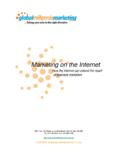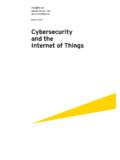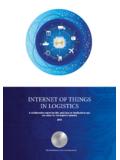Transcription of What Is The In ternet (And What Makes It Work) - …
1 1 What Is The internet (And What Makes It Work) - December, 1999 By Robert E. Kahn and Vinton G. Cerf In this issue: INTRODUCTION THE EVOLUTION OF THE internet THE internet ARCHITECTURE GOVERNMENT S HISTORICAL ROLE A DEFINITION FOR THE internet WHO RUNS THE internet WHERE DO WE GO FROM HERE? This paper was prepared by the authors at the request of the internet Policy Institute (IPI), a non-profit organization based in Washington, , for inclusion in their upcoming series of internet related papers.
2 It is a condensation of a longer paper in preparation by the authors on the same subject. Many topics of potential interest were not included in this condensed version because of size and subject matter constraints. Nevertheless, the reader should get a basic idea of the internet , how it came to be, and perhaps even how to begin thinking about it from an architectural perspective. This will be especially important to policy makers who need to distinguish the internet as a global information system apart from its underlying communications infrastructure.
3 INTRODUCTION As we approach a new millennium, the internet is revolutionizing our society, our economy and our technological systems. No one knows for certain how far, or in what direction, the internet will evolve. But no one should underestimate its importance. Over the past century and a half, important technological developments have created a global environment that is drawing the people of the world closer and closer together.
4 During the industrial revolution, we learned to put motors to work to magnify human and animal muscle power. In the new Information Age, we are learning to magnify brainpower by putting thepower2 of computation wherever we need it, and to provide information services on a global basis. Computer resources are infinitely flexible tools; networked together, they allow us to generate, exchange, share and manipulate information in an uncountable number of ways.
5 The internet , as an integrating force, has melded the technology of communications and computing to provide instant connectivity and global information services to all its users at very low cost. Ten years ago, most of the world knew little or nothing about the internet . It was the private enclave of computer scientists and researchers who used it to interact with colleagues in their respective disciplines. Today, the internet s magnitude is thousands of times what it was only a decade ago.
6 It is estimated that about 60 million host computers on the internet today serve about 200 million users in over 200 countries and territories. Today s telephone system is still much larger: about 3 billion people around the world now talk on almost 950 million telephone lines (about 250 million of which are actually radio-based cell phones). But by the end of the year 2000, the authors estimate there will be at least 300 million internet users.
7 Also, the total numbers of host computers and users have been growing at about 33% every six months since 1988 or roughly 80% per year. The telephone service, in comparison, grows an average of about 5-10% per year. That means if the internet keeps growing steadily the way it has been growing over the past few years, it will be nearly as big as today s telephone system by about 2006. THE EVOLUTION OF THE internet The underpinnings of the internet are formed by the global interconnectionof hundreds of thousands of otherwise independent computers, communications entities and information systems.
8 What Makes this interconnection possible is the use of a set of communication standards, procedures and formats in common among the networks and the various devices and computational facilities connected to them. The procedures by which computers communicate with each other are called "protocols." While this infrastructure is steadily evolving to include new capabilities, the protocols initially used by the internet are called the "TCP/IP" protocols, named after the two protocols that formed the principal basis for internet operation.
9 3 On top of this infrastructure is an emerging set of architectural concepts and data structures for heterogeneous information systems that renders the internet a truly global information system. In essence, the internet is an architecture, although many people confuse it with its implementation. When the internet is looked at as an architecture, it manifests two different abstractions. One abstraction deals with communications connectivity, packet delivery and a variety of end-end communication services.
10 The other abstraction deals with the internet as an information system, independent of its underlying communications infrastructure, which allows creation, storage and access to a wide range of information resources, including digital objects and related services at various levels of abstraction. Interconnecting computers is an inherently digital problem. Computers process and exchange digital information, meaning that they use a discrete mathematical binary or two-valued language of 1s and 0s.








